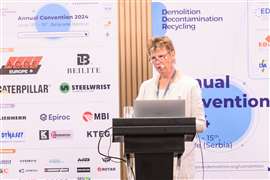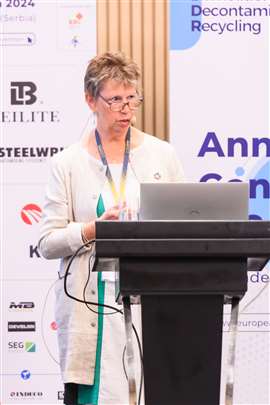How to deal with CFC-containing materials
24 June 2024
Expert insight on hazardous material handling and the recycling of insulating materials
Over 200 demolition industry professionals gathered in Belgrade, Serbia, recently for the EDA annual convention.
While the event kicked off with a day of workshops, expert presentations on the second day of the convention provided attendees with a wealth of knowledge.
Key among them was a presentation delivered by expert environmental consultant and bio-geoscientist Marianne Hedberg Miljobygge, who provided insight into the handling and treatment of hazardous substances.
Dealing with hazardous waste: Insulations and CFCs
Marianne explained and discussed the direct - but often overlooked - impact that insulation has on the earth’s Ozone layer.
 Environmental consultant and bio-geoscientist Marianne Hedberg Miljobygge, speaking at the EDA Annual Convention in Belgrade, Serbia. (PHOTO: EDA)
Environmental consultant and bio-geoscientist Marianne Hedberg Miljobygge, speaking at the EDA Annual Convention in Belgrade, Serbia. (PHOTO: EDA)
Marianne referenced the 1989 international Montreal Protocol on Ozone Depleting Substances and its 2016 update, which bans the production and use of chlorofluorocarbons (CFCs) and hydrofluorocarbons (HFCs) and other manmade chemicals (greenhouse gases) used in refrigerants, insulating foams and air-conditioning.
When CFC compounds are released into the atmosphere they make their way up into the earth’s stratosphere, and start to react with the Ozone.
Ozone (O3) is a highly reactive gas made up of three oxygen atoms, that protects the planet from the ultraviolet radiation in space. When CFCs and HFCs mix with the Ozone, they break down the O3 into oxygen (O2), which does not filter out the ultraviolet radiation from space.
“But the CFCs are just a catalyst,” said Marianne. “They take part in the reaction, in the splitting of the O3 into O2, and then go off to the next reaction. And the next reaction, and the next and so on.
“This is why CFCs are so damaging. The compound will eventually break down, but not quickly. If fact, not for 100 years,” she said.
“So whatever was whatever CFCs were produced in the 1970s are still up there, reacting with our Ozone layer”.
How demolition contractors should handle insulation
So, what does this mean for demolition, decommissioning and decontamination contractors when dealing with insulation?
Marianne explained that “at the time when each piece of insulation was created, it was done by taking the material - polyurethane, for example, and blowing [inflating] it up with a CFC gas.
“And whatever CFC gas was used, still remains in the material’s pores today. Even though it may have been produced in the 1970s or earlier.”
“So, you can see that we have a bit of a problem with this insulation because it is still in many structures around the world. To take care of these materials we need special understanding.”
Marianne added that when any insulation containing material, such as insulated piping, sandwich boards and refrigeration products, are cut, torn or crushed on work sites during the demolition and sorting processes, these CFCs are released into the atmosphere.
She said: “It might be tempting to take metal-covered foam insulation, sandwich boards and other items and send it to a metal scrap dealer, and to get something [money] for it.”
“But then the material is crushed in open air. And what happens to the gas is contained within the insulation and foams? They go up into the stratosphere. And destroy the ozone layer.
Where is this insulation found?
- Sandwich walls for cold storage
- Refigerators and freezers
- Refigerated containers
- Truck lockers
- Caravans
- Pipes for district heating and cooling
- Front blanked course
- Insulation board in walls, roofs and ground
To prevent this, Marianne said that demolition contractors must seek out and utilise the services of special recyclers that have the appropriate equipment and permits to safely separate the recyclables from the insulation materials, prior to their incineration.
 (PHOTO: EDA)
(PHOTO: EDA)
“This is where the regulations may seem a little bit costly, because the machinery that handles the insulation has to be enclosed in an airtight space.
“Then the pressure of that space has to be reduced to prevent explosions and fire, and after that the material can be crushed.
“Solid, reusable material is then taken out for all recycling - a very high percentage can be recovered. And the hazardous gas can be taken care of by being condensed into a fluid state that can then be sent for destruction.
“It has to be incinerated at 1,200 degrees Celsius or above,” Marianne explained, “Otherwise it will just pass through the process.
“If you send your waste insulation material to just an ordinary recycler or waste management company, the incineration temperature utilised usually only goes up to 850 degrees Celsius, and that is not enough to destroy this hazardous substance.
“So, this is why we need contractors to use proper plants that can handle these materials. These plants must have the appropriate permit to be able to do this.”
According to Marianne, Sweden currently has two specialist waste management companies that have the required equipment and permits to carry out this work.
The European Environmental Agency estimates that only 10% of CFC and HFC containing insulation materials are dealt with in the proper manner.
Regulations on F-gases and substances that deplete the Ozone layer
Article 8 Recovery and Destruction / Article 20 Recovery and Destruction of used Ozone-depleting substances
8/2. From 1 January 2025, building owners and contractors shall ensure that, during renovation, refurbishing or demolition activities implying the removal of foam panels that contain foams with fluorinated greenhouse gases listed in Annex I and in Section 1 of Annex II, emissions are avoided to the extent possible by handling the foams or the gases contained therein in a way that ensures the destruction of those gases.
In the case of recovery of those gases, the recovery shall be carried out only by appropriately qualified natural persons.
9/3....foams in laminated boards installed in cavities or built-up structures that contain fluorinated greenhouse gases listed in Annex I and in Section 1 of Annex II.




